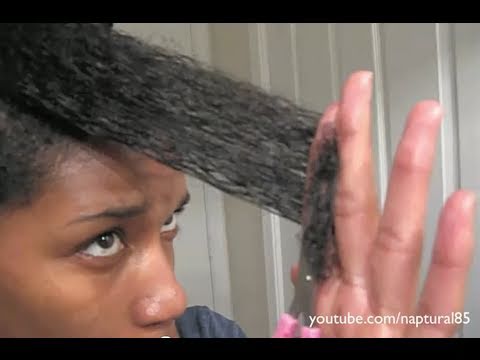
Have you ever wondered why your hair doesn't seem to grow any longer once it reaches a certain length? It's because the hair occasionally breaks. Breakage can prevent you from reaching your hair growth goals.
What's the breaking point?
It is when your hair stays at a set length and doesn't seem to grow anymore. This breakage point happens when the hair's cuticle layers get thinner as the hair grows. The thinner the layers get, the more prone they are to split ends and breakage.
Is trimming natural hair required to combat breakage? In this article, we teach you how to trim your own hair and cut split ends at home, just like a professional hair stylist.
Table of Contents
There are some people who can grow their hair very long without needing a periodic trim. This could imply that these people have longer breakage points.
Each person's hair is different, so it's important to really pay attention to the needs of your hair. For some people, occasional hair trimming helps because it cleans up the breaking point and split ends.

Does Trimming Natural Hair Encourage Hair Growth?
Trimming natural hair does not directly encourage hair growth or length retention. It also doesn't guarantee a longer breakage point. Trimming healthy natural hair makes it shorter. However, there are benefits to trimming natural hair.
Hair trimming should be done to remove thinning hair cuticles and to mitigate breakage. Trimming is meant to slow breakage or even stop it for a while so that your hair has the ability to continue growing versus breaking off.
The strands of our hair get thinner as they grow away from the scalp. As the hair tapers off, the cuticle wears away. The microscopic layers get stripped off one layer at a time.
The hair is weaker at the ends and is more susceptible to damage from various elements. The ends are older because new growth continuously pushes them farther from the scalp.
Over time the hair also becomes more susceptible to potential damage from normal styling techniques, such as washing, combing, and heat styling as examples.
How to Trim Your Natural Hair at Home
The video below features Whitney White, aka Naptural85, providing a step-by-step hair trimming tutorial. Check out how she divides the hair into small sections. These small sections are twisted up after the hair is trimmed to keep the strands separated.
Methods for Trimming Natural Hair at Home
Trimming is definitely beneficial because it removes split ends and cuts off knots that can't be unraveled.
Aesthetically speaking, it makes the cuticle ends as sharp and healthy as possible. The older dead ends are removed.
When trimming your hair, there are three factors to consider:
- The length of your hair
- How much hair damage do you have
- How much hair length you're willing to sacrifice
Keep in mind that a really sharp pair of trimming scissors is necessary for the cleanest cut possible (i.e., creates a more precise cut).
Use hair scissors and not just any pair of household scissors (e.g., kitchen scissors) lying around your home because hair scissors are made for the job. Regular scissors are not designed to cut hair.
Be sure to use a mirror, and of course, trim your hair in a bright environment with sufficient lighting.

1. Search and Destroy Mission
Search and destroy sounds like a classified military operation. However, in this instance, it's actually a very popular method for cutting hair.
The thought is to search for sections of damaged hair and destroy them immediately.
To utilize the method, take small sections of your hair (roughly one square inch) and search through it for split ends, frayed spots, fairy knots, and breakage points.
The goal is to cut or trim the hair about one-fourth of an inch above the damage point. This trimming technique can be used as often as needed.
However, if you find yourself frequently conducting these search-and-destroy missions, it's best to consider a more comprehensive trimming method.

2. Dusting Method
If you regularly see knots and split ends in your hair, you should consider using the dusting method. The purpose is to contain the damage, keeping it from spreading further.
Using this method, you should regularly cut a small amount of hair (no more than a quarter inch) about once every two months.
However, if you're trying to grow long hair, then this method probably isn't appropriate. You should try the search-and-destroy method instead.
The biggest advantage of the dusting method is the regularity with which your hair is cut. The goal is preventative maintenance. The biggest disadvantage, however, is that it won't help much if the damage is already further up the hair strand.
This means that if you want dusting to work, you'll have to keep an eye on your ends. Dusting is a practical application of the old adage, "a stitch in time saves nine".
Take note of the fact that for dusting to work, your hair needs to be in decent condition. The only way for dusting to function properly is if the damage is at the ends (or tips) of your hair strands.

3. Full Trim
Getting a regular trim may seem similar to dusting, but it has a different goal. Dusting is about general maintenance, designed to remove damage in the form of splits and knots.
Trimming is designed to establish a healthy base of hair since it takes off more length than a dusting. This can enable you to use the dusting method or conduct a search-and-destroy mission in the future.
We generally consider cutting your hair "a trim" when you cut off more than half an inch. It's common for many ladies to get regular trims every few months.
The biggest advantage to getting regular trims is that it helps you keep a healthy base of hair. It essentially gets rid of ends that have the potential to become damaged before they have a chance to do so.
The downside, however, is that regular trims make it harder to gain length.
If your hair grows particularly slowly, you may not be able to gain length at all. This does mean, however, that getting a regular trim can maintain your current hairstyle if that's what you wish to do.
Should You Trim Natural Hair When Wet Or Dry?
Trimming your hair while it's wet may not be a problem for those with straight hair (type 1). Type 1 hair usually doesn't have as many issues with porosity as curly hair. It's also not as vulnerable to shrinkage.
However, if you have color-treated hair, chemically relaxed hair, or simply non-uniform curl patterns, then you should choose dry trimming (or the dry hair trimming method).
One simple experiment that you can use to illustrate the example is cutting a piece of paper. Imagine cutting a piece of paper while it's wet versus cutting a piece of dry paper.
It's not difficult to notice that the cut on wet paper is a messy-looking cut. You'll have the exact same problem with your hair. Not only will the cut be messy, but you could actually damage the new ends.
Which would obviously defeat the entire purpose of trimming.
And if you use scissors that are dull or simply not designed for hair, it's possible that you'll do even more damage. Using blunt, dull scissors creates a jagged cut.
Using a sharp pair of scissors, or at least well-maintained hair shears, will produce a clean cut. If you can, go with professional hair shears instead of paper scissors.
They may be slightly more expensive, but they're worth it if you'll be trimming your hair periodically. A sharp pair of paper scissors can be used, of course. Just make sure they make a quick, clean cut.
You want to avoid getting hair trapped between the blades. This is one of the primary reasons why hair shears are preferable.
Wet hair looks longer, which makes it difficult to determine how much hair you're actually trimming. Many ladies have trimmed their hair while it's wet, only to find that their hair is much shorter than expected once it dries.
Also, due to the differences between texture and porosity throughout your hair, dry trimming is simply more precise. With textured hair, you may have some hair strands stretch longer than others when they get wet.
In addition, areas that are more tightly coiled might not release as fully as looser curled areas. This means that wet trimming can leave you with uneven hair.
- How Often Should You Cut Your Hair
- How to Thin Out Hair Without Thinning Shears
- How Much Hair Is Cut Off in a Trim
- What Is a Trim for Hair?
Trimming your own natural hair at home can be daunting, but it is certainly doable with the right tools and information. We’ve outlined our favorite methods for trimming your curly natural hair. Remember to use sharp hair-cutting shears and trim in a bright environment. Good luck!





